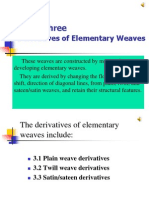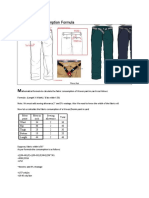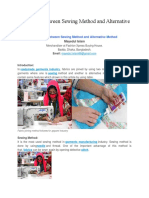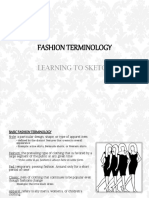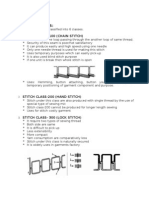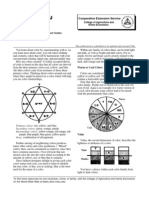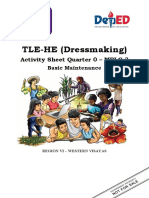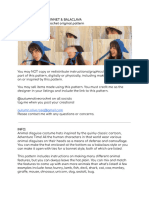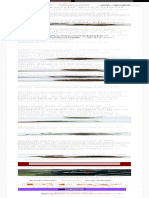Patch Pockets PDF
Patch Pockets PDF
Uploaded by
Tesfaye MuluCopyright:
Available Formats
Patch Pockets PDF
Patch Pockets PDF
Uploaded by
Tesfaye MuluOriginal Description:
Original Title
Copyright
Available Formats
Share this document
Did you find this document useful?
Is this content inappropriate?
Copyright:
Available Formats
Patch Pockets PDF
Patch Pockets PDF
Uploaded by
Tesfaye MuluCopyright:
Available Formats
College of Agriculture and Home Economics
N EW
Patch Pockets
Guide C-225
Susan Wright, Extension Clothing and Textiles Specialist
Cooperative Extension Service
EX
IC O
S
Y
TE TA
This publication is scheduled to be updated and reissued 3/06.
IV
E RSI
Patch pockets may be used for decoration or function on blouses, shirts, and jackets. To prepare the pockets, cut the pocket as directed by the pattern. Patch pockets are generally cut on the lengthwise grain; however, a bias-cut pocket may be used on plaid or striped fabric to avoid having to match the fabric design. An interfacing will help preserve the shape of the pocket. If a fusible interfacing is used, cut it to the finished pocket size and fuse in place. If a sew-in interfacing is used, cut it by the pocket pattern, staystitched in place, then trim it close to the staystitching. The hem of the pocket does not need to be interfaced.
Square Pocket
4. To miter corners of pocket, fold bottom corners diagonally to line up stitching lines and press (fig. 2). Trim points to 1/4 seam allowance. Turn side seam allowance up and press to form mitered corners (fig. 3).
Fig. 2
1. Apply interfacing.
Fig. 3
2. Finish edge hem. Fold the hem to right side of pocket and stitch around pocket on 5/8 line. Stitch from top to bottom on each side, then stitch from side to side across the bottom (fig. 1).
5. Pin pocket in position on garment. Topstitch in place beginning at center of bottom and stitch to top of pocket on each side.
Fig. 1
Fig. 4
3. Trim seam allowance of hem close to stitching (fig. 1). Turn hem right side out. Press pocket seam allowance along 5/8 stitching line.
6. Secure and reinforce top of pocket by sewing a bar tack or triangle in each corner (fig. 4).
To find more resources for your business, home, or family, visit the College of Agriculture and Home Economics on the World Wide Web at www.cahe.nmsu.edu
Rounded Patch Pockets
1. Applying interfacing. 2. Finish edge of hem. Fold to right side of pocket and stitch around pocket on 5/8 seamline. To avoid stretching pocket, stitch from center bottom to top on each side (fig. 5).
Fig. 8
7. Trim and notch seam allowance if necessary to reduce puckers (See fig. 9).
Fig. 5
3. Trim the seam allowance of hem close to stitching. Turn hem right side out and press. 4. Sew a row of gathering stitches on the 3/8 line around bottom of pocket (fig. 6).
Fig 9
8. Press pockets to form even, matching curves on each side of pocket(See fig. 10).
Fig. 10 Fig. 6
5. Trim seam allowances of rounded edges close to gathering stitches (fig. 7).
Tip: A pocket template can be cut from cardboard and used as a guide when pressing pockets into the correct shape. Lay template over the wrong side of the pocket and press the seam allowance in place over the template. 9. Pin pocket in position. Topstitch in place beginning at the bottom center and sew toward the top pocket on each side. 10. Secure and reinforce the top of pocket by backstitching or sewing a triangle in each corner (See fig. 4).
Fig. 7
6. Pull up the gathering stitches around the curves just enough to shape the pocket curve along the 5/8 stitching (See fig. 8).
New Mexico State University is an equal opportunity/affirmative action employer and educator. NMSU and the U.S. Department of Agriculture cooperating.
Reprinted March 2001
Guide C-225 Page 2
Las Cruces, NM 5C
You might also like
- Pattern Development: 1) Draping Method 2) Drafting Method 1) DrapingDocument4 pagesPattern Development: 1) Draping Method 2) Drafting Method 1) Drapingmaya_muth100% (2)
- YokeDocument31 pagesYokeRemya0% (1)
- Gadwal SareesDocument131 pagesGadwal Sareessurbhimo83% (6)
- K To 12 Handicrafts Learning ModuleDocument83 pagesK To 12 Handicrafts Learning ModuleNeca Borromeo82% (57)
- For Other Uses, See: Batik (Javanese PronunciationDocument18 pagesFor Other Uses, See: Batik (Javanese PronunciationRama Arumugam RamaNo ratings yet
- PlacketsDocument22 pagesPlacketsDivyanshi GoelNo ratings yet
- Salinta MononDocument2 pagesSalinta MononHot JoonNo ratings yet
- Practical Manual: Garment Construction Paper Iii - I Year (Voc)Document13 pagesPractical Manual: Garment Construction Paper Iii - I Year (Voc)Srini KalmulaNo ratings yet
- Introd TextileDocument25 pagesIntrod TextileNila Kumar Singha100% (1)
- 561566642977unit-3 - TextilesDocument11 pages561566642977unit-3 - TextilesGaganpreet Kaur Fashion DesigningNo ratings yet
- Importance of Drafting PDFDocument9 pagesImportance of Drafting PDFGina MuringNo ratings yet
- Sewing TermsDocument2 pagesSewing Termsmichutty100% (1)
- Sewing ProbDocument18 pagesSewing ProbAminur RahmanNo ratings yet
- Sewing ProcessDocument28 pagesSewing ProcessRaja manimaranNo ratings yet
- Cutting Room Terminologies in Apparel IndustryDocument2 pagesCutting Room Terminologies in Apparel IndustrySatadeep DattaNo ratings yet
- 2 Collars DrapingDocument5 pages2 Collars Drapingapi-524713965No ratings yet
- I K G TDocument37 pagesI K G TAbhishek kushwahaNo ratings yet
- Sewing Tools and EquipmentDocument2 pagesSewing Tools and EquipmentMarthaNo ratings yet
- Stitch TypesDocument21 pagesStitch TypesAjaz777100% (2)
- Yardage Control in Cutting RoomDocument6 pagesYardage Control in Cutting RoomSupreet kaur behlNo ratings yet
- FINALDocument63 pagesFINALKhushbu DinkarNo ratings yet
- Different Categories of GarmentsDocument19 pagesDifferent Categories of GarmentsPragati JoshiNo ratings yet
- Apparel CategoriesDocument75 pagesApparel CategoriesNiharika SharmaNo ratings yet
- Derivatives of Elementary WeavesDocument20 pagesDerivatives of Elementary WeavesAswathy Unnikrishnan100% (1)
- Basics of Fibre To FabricDocument33 pagesBasics of Fibre To FabricNoelle Sawyer100% (2)
- My Lesson PlanDocument17 pagesMy Lesson PlanAlcueno JheckaNo ratings yet
- Clothes Different Kinds of TopsDocument1 pageClothes Different Kinds of TopsPaula PenelasNo ratings yet
- Textile ScienceDocument6 pagesTextile ScienceJanah SevillaNo ratings yet
- Post Independence IndiaDocument3 pagesPost Independence IndiaPratima GhegadeNo ratings yet
- Garment Production and Machinery EquipmentsDocument31 pagesGarment Production and Machinery EquipmentsShreya Bahl100% (1)
- Fabric IdentificationDocument26 pagesFabric IdentificationSmita PoojaryNo ratings yet
- Fo Fashion - Cycle - TheoriesDocument28 pagesFo Fashion - Cycle - TheoriesApurva NidhiNo ratings yet
- Commercial PatternDocument11 pagesCommercial PatternShantejah MitchellNo ratings yet
- Sewing TermsDocument2 pagesSewing Termsrobert mametsaNo ratings yet
- Lesson 9 Clothing ConstructionDocument10 pagesLesson 9 Clothing ConstructionEmerson John RoseteNo ratings yet
- Kasidha of KashmirDocument10 pagesKasidha of KashmirAnindya ChandraNo ratings yet
- Basics of Weaving and Woven FabricsDocument22 pagesBasics of Weaving and Woven Fabricsayushi bhansaliNo ratings yet
- BandhniDocument8 pagesBandhnidhiyamampilly100% (3)
- Feed Mechanism in Sewing MachineDocument4 pagesFeed Mechanism in Sewing Machinetamanna mainiNo ratings yet
- SEWN PRODUCTS MACHINERY AND EQUIPMENT ModelDocument8 pagesSEWN PRODUCTS MACHINERY AND EQUIPMENT ModelUjwala Jain0% (1)
- EmbellishmentDocument26 pagesEmbellishmentpheiyingNo ratings yet
- Sewing ThreadsDocument39 pagesSewing ThreadsAnkit ChandorkarNo ratings yet
- Rural Focus Initiative-Uganda (Rufi-U) .: Curriculum For Tailoring & Garment CuttingDocument7 pagesRural Focus Initiative-Uganda (Rufi-U) .: Curriculum For Tailoring & Garment CuttingHENRY NSEREKONo ratings yet
- Overlock: MachineDocument51 pagesOverlock: MachineShweta ChauhanNo ratings yet
- Woven Pant Consumption FormulaDocument16 pagesWoven Pant Consumption FormulaRabi KantNo ratings yet
- Seams NotesDocument2 pagesSeams Notestoniiann100% (1)
- FoldersDocument7 pagesFoldersKayes ChowdhuryNo ratings yet
- CountDocument15 pagesCountrezowan555No ratings yet
- Garment AccessoriesDocument17 pagesGarment AccessoriesVikas SinghNo ratings yet
- Kashidakari and SozniDocument24 pagesKashidakari and SozniShivani Goel67% (3)
- Fabric Science-Ii: Subject Code: 17UTF09Document111 pagesFabric Science-Ii: Subject Code: 17UTF09Sweatha S100% (1)
- Seams and Seams FinishingDocument14 pagesSeams and Seams FinishingShivamNo ratings yet
- Winifred Aldrich - Metric PattBlackwell Science) - Libgen - LC 13Document1 pageWinifred Aldrich - Metric PattBlackwell Science) - Libgen - LC 13mefaisal750% (1)
- Difference Between Sewing Method and Alternative Method4Document40 pagesDifference Between Sewing Method and Alternative Method4sabberNo ratings yet
- Bhagalpuri SareeDocument10 pagesBhagalpuri SareeASTHANo ratings yet
- Seawing Room SubmisiionDocument22 pagesSeawing Room SubmisiionEhsanAhmedNo ratings yet
- Fashion Terminology PPT - Ms Krysten DaneDocument5 pagesFashion Terminology PPT - Ms Krysten DaneEniola100% (1)
- Types of SleevesDocument5 pagesTypes of SleevesLorenz Ruiz RomeroNo ratings yet
- Fabric CharacteristicsDocument41 pagesFabric CharacteristicsTesfaye MuluNo ratings yet
- Fashion Feasibility PDFDocument4 pagesFashion Feasibility PDFTesfaye Mulu100% (1)
- Different Types of StitchesDocument7 pagesDifferent Types of StitchesTesfaye MuluNo ratings yet
- Clothing Hints For Youth Children PDFDocument2 pagesClothing Hints For Youth Children PDFTesfaye MuluNo ratings yet
- Zippers Made Easily PDFDocument8 pagesZippers Made Easily PDFTesfaye Mulu100% (1)
- Check Your Pattern For Proper Fit PDFDocument4 pagesCheck Your Pattern For Proper Fit PDFTesfaye Mulu100% (1)
- Zippers Made Easily PDFDocument8 pagesZippers Made Easily PDFTesfaye Mulu100% (1)
- Stitch TypesDocument21 pagesStitch TypesAjaz777100% (2)
- Colour and You PDFDocument2 pagesColour and You PDFTesfaye MuluNo ratings yet
- Common Machine Trouble PDFDocument2 pagesCommon Machine Trouble PDFTesfaye MuluNo ratings yet
- Brother Overlock 1034DDocument68 pagesBrother Overlock 1034DsenditalNo ratings yet
- EthiopiaDocument32 pagesEthiopiaTesfaye Mulu100% (1)
- Code of Conduct For Faculty and Procedures For Taking Disciplinary ActionDocument10 pagesCode of Conduct For Faculty and Procedures For Taking Disciplinary ActionTesfaye MuluNo ratings yet
- Business PlanDocument56 pagesBusiness PlanTesfaye Mulu100% (3)
- List of Content PageDocument2 pagesList of Content PageTesfaye MuluNo ratings yet
- NV950 SettingDocument32 pagesNV950 SettingBadrulhasya AdnanNo ratings yet
- Freddy Krueger En-1Document19 pagesFreddy Krueger En-1Verónica Rodríguez Escudero100% (1)
- TLE-HE (Dressmaking) : Activity Sheet Quarter 0 - MELC 3Document18 pagesTLE-HE (Dressmaking) : Activity Sheet Quarter 0 - MELC 3Mari PagxNo ratings yet
- Annexure: SRH.47 Sri Senthil AndavarDocument26 pagesAnnexure: SRH.47 Sri Senthil AndavarSenniveera GovinthNo ratings yet
- Animal Disguise Bonnet and BalaclavaDocument19 pagesAnimal Disguise Bonnet and BalaclavaLara BriceñoNo ratings yet
- Panda Bear Amigurumi Crochet Pattern - Free! - Angie's Art StudioDocument9 pagesPanda Bear Amigurumi Crochet Pattern - Free! - Angie's Art StudioKatherine Hernandez Espinoza100% (1)
- Meemanan - MushroomDocument8 pagesMeemanan - MushroomFeeny Zhang100% (4)
- Viking 940 Prisma XDocument62 pagesViking 940 Prisma XLM SmithNo ratings yet
- Knitting ProcessDocument8 pagesKnitting ProcessDhana SeelanNo ratings yet
- Basic Sewing Steps Basic Sewing Steps Basic Sewing Steps Basic Sewing StepsDocument23 pagesBasic Sewing Steps Basic Sewing Steps Basic Sewing Steps Basic Sewing StepsGrama100% (1)
- Bobble Baby Beanie PDFCrochet PatternDocument19 pagesBobble Baby Beanie PDFCrochet Patternalix.moity100% (3)
- Bride DollDocument32 pagesBride DollApoorva Gowda100% (8)
- Optional Short Row Shaping For Flax and Flax Light: The Simple CollectionDocument4 pagesOptional Short Row Shaping For Flax and Flax Light: The Simple CollectionAMJAAD ,No ratings yet
- Pinky Blue MilfeiCakeDocument18 pagesPinky Blue MilfeiCakePhi Phi100% (4)
- Soft+Sage+Circle+Jacket+ +yarn+ +Free+Knitting+Patterns+ +Crochet+Patterns+ +yarnspirations PDFDocument5 pagesSoft+Sage+Circle+Jacket+ +yarn+ +Free+Knitting+Patterns+ +Crochet+Patterns+ +yarnspirations PDFsweetangelcgn100% (1)
- AvesDocument79 pagesAvesFabijulu Castel100% (2)
- World Turtle Succulent Holder - Knot BadDocument1 pageWorld Turtle Succulent Holder - Knot BadAILEEN JOARY LOZANO SALGADO 17ADG0034FNo ratings yet
- Cheyenne Sweater Vest Pattern-2Document2 pagesCheyenne Sweater Vest Pattern-2mariacarcau08No ratings yet
- Beaded Chain Barefoot SandalsDocument8 pagesBeaded Chain Barefoot SandalsbrandilaelelliottNo ratings yet
- Stones RosesDocument4 pagesStones Rosesmahira_tippuNo ratings yet
- Pipizzuella Crochet - Maira Tessino - Little Mermaid - Crochet PatternDocument5 pagesPipizzuella Crochet - Maira Tessino - Little Mermaid - Crochet PatternGabriela Yus100% (1)
- DROPS 50-5 - DROPS Cardigan in Tynn Chenille - Free Pattern by DROPS DesignDocument1 pageDROPS 50-5 - DROPS Cardigan in Tynn Chenille - Free Pattern by DROPS DesignkamileNo ratings yet
- Weaving Loom Parts Catalogue Sulzer Rapier SpareDocument51 pagesWeaving Loom Parts Catalogue Sulzer Rapier SpareRahul k Meghavath RahulNo ratings yet
- Grumpy Mini OctopusDocument4 pagesGrumpy Mini Octopusprincessashlynnthe1st100% (3)
- Iron BuddyDocument11 pagesIron BuddyAngie Diaz100% (2)
- Alok Industries - InternshipDocument42 pagesAlok Industries - InternshipSurya Bakshi80% (5)
- Knitted PigletDocument17 pagesKnitted Pigletholisuwu2009100% (2)
- Amigurumi Bunny Pofoo Crochet Free PDF PatternDocument6 pagesAmigurumi Bunny Pofoo Crochet Free PDF Patternhartmannandrew260No ratings yet























